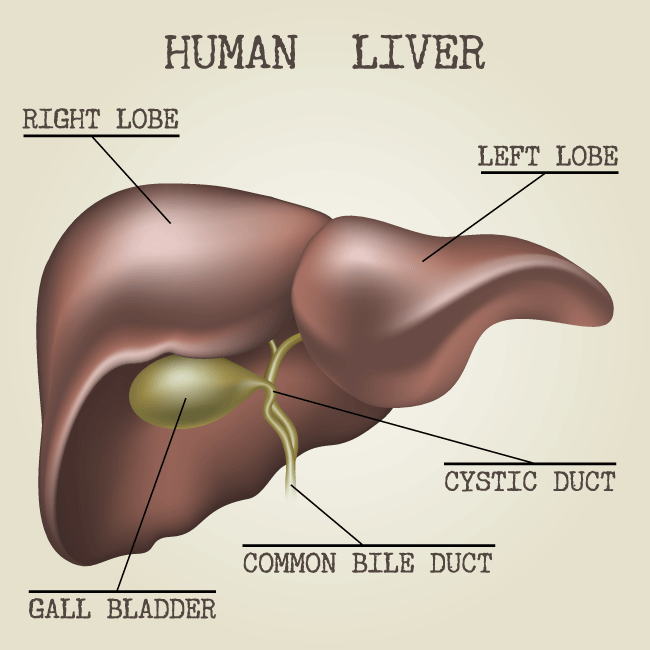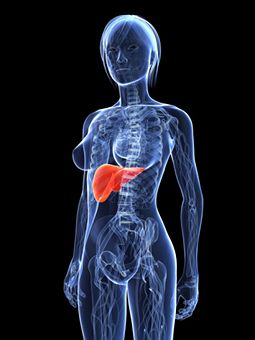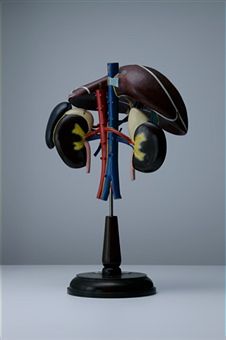The liver is one of the most important organs in the human body. As the largest organ inside the body, it is about the size of an American football and weighs 2 to 3 pounds. The liver is located in the upper-right quadrant of the abdomen, under the rib cage. It is composed of two lobes, and each of those are made up of smaller lobules.
Oxygen is supplied to the liver from the hepatic artery, while supporting nutrients are delivered via the portal vein. The portal vein flows to the liver through the intestines and spleen, where it delivers both important nutrients for protein and cholesterol production and chemicals that need to be detoxified.
Functions of Your Liver

The liver has several functions and is considered one of the busiest “factories” in the body. Some of the main functions of the liver are to create components of the blood from raw nutrients, produce necessary enzymes and proteins, balance hormone levels, and metabolize foreign substances in the body, detoxifying it. In addition, the liver plays a secondary role in maintaining the immune system and is responsible for creating bile, which aids in digestion. Because the liver produces bile, it is not only an organ but, medically speaking, a gland. Once the bile is produced, it travels to the gall bladder for storage.

There is no one ailment known as “liver disease.” Liver disease is a generalized term for several different maladies that affects the normal functioning of the liver, the loss of which can cause grievous injury to the rest of the body.
Doctors have pushed to limit the use of the term, in favor of the more specific diseases, but the term continues to persist. Liver disease is also sometimes known as hepatic disease.
The liver is a very hardy organ and the only part of the body that can regenerate itself. Even so, liver disease can cause the widespread failure of the organ once the disease has caused 3/4 of it to shut down. Before this time, the liver will still function properly.
Liver Disease? Get Remedies Fast!
Causes of Liver Disease
Liver disease is a broad category of other, more specific, diseases. These specific conditions that cause liver disease can work alone or in conjunction. One disease, often leads to another, more severe form.
The two most common forms of liver disease are cirrhosis and hepatitis. In cirrhosis, normal liver tissue is replaced with non-functional scar tissue that never heals. If a direct cause of the liver disease can be determined, it is possible to stop it from destroying any more of the organ. Other types of liver disease can damage the organ through inflammation, obstruction of bile, accumulation of cholesterol, decreased blood flow, foreign chemicals, or abnormal cell growth. Here are some of the diseases that are grouped into this category:
- Alcohol hepatitis – Consumed alcohol directly affects the liver and is a poison to it, causing it to become inflamed. Fat deposits can accumulate in the liver due to chronic alcohol abuse, causing malfunction and failure. Alcohol abuse may also cause other, more severe forms of liver disease.
- Cirrhosis – The scarring of the liver and subsequent loss of function. It is considered a late-stage form of liver disease.
- Drug-induced liver disease – Several medications are extremely toxic to the liver and can cause permanent damage. Some of these medications can cause damage at prescribed doses, while others require an overdose or excessive use. Acetaminophen (Tylenol) is one common over-the-counter drug that can cause liver damage. Cholesterol-controlling drugs, known as statin medications, are also toxic to the liver. Other drugs that can cause liver damage are niacin, nitrofurantoin, amoxicillin, tetracycline, isoniazid, methotrexate, and disulfiram. Additionally, some natural herbs and herbal remedies can cause liver disease. Herbal or natural plants causing liver disease are ma-huang, kava-kava, and many types of poisonous mushrooms.
- Hepatitis A – There are five types of hepatitis. Type A is a caused by a virus that is generally transmitted via accidental ingestion of feces. It causes serious inflammation that may resolve itself. A preventative vaccine exists for hepatitis A.
- Hepatitis B – This type of hepatitis spreads through direct contact of bodily fluids (shared needles, blood transfusions, sex). It can become chronic and lead to cirrhosis or even cancer. A vaccine also exists for hepatitis B.
- Hepatitis C – This type is also spread via direct transmission through bodily fluids. It is a chronic illness that often leads to cirrhosis or cancer. No vaccine exists for hepatitis C.
- Hepatitis D – This is caused by a virus that is transmitted concurrently with the hepatitis B virus. The D virus cannot live without the presence of the B virus.
- Hepatitis E – Hepatitis E can be transmitted through food and water that has been contaminated.
- Viral liver disease – Other than the hepatitis virus, several different viral infections can cause liver damage, including mononucleosis (Epstein-Barr), adenovirus, and cytomegalovirus.
- Non-alcoholic fatty liver disease – This disease causes fatty deposits to collect in the liver that interrupt its normal functioning.
- Hemochromatosis – This is a disorder in which the body has a problem metabolizing iron, causing it to build up. The extra iron can get caught in the liver, among other organs, leading to inflammation and failure.
- Liver cancer
- Wilson’s disease – Wilson’s disease is a genetic disorder like hemochromatosis, except it affects the body’s ability to metabolize copper.
- Gilbert’s syndrome – This is a common disease, affecting up to 7% of all people in North America. It causes abnormal metabolizing of bilirubin. Gilbert’s usually causes no major harm, no symptoms, and often requires no treatment.
- Budd Chiari syndrome – This condition causes blood clots to build in the hepatic vein, decreasing blood flow through the organ. It can both increase blood pressure and lead to more serious forms of liver disease. Budd Chiari syndrome has several causes, including pregnancy, sickle cell anemia, and inflammatory bowel disease.
- Congestive heart failure – While congestive heart failure is more detrimental to the circulatory system, it can also adversely affect the liver.
- Bile obstruction – If bile becomes obstructed from the liver to the gall bladder or from the gall bladder to the intestine, the liver can become inflamed. The most common cause of bile obstruction is gallstones. Some people also have a congenital deformation in the bile ducts that can cause obstruction.
Symptoms of Liver Disease
Liver disease has several symptoms that are in common, no matter the exact cause:
- Abdominal pain
- Nausea
- Vomiting
- Jaundice – an apparent yellowing of the skin caused by elevated bilirubin.
- Weakness
- Fatigue
- Weight loss
If the liver disease is caused by or develops into cirrhosis, the following symptoms can occur in addition to the general symptoms:
- Bruising becomes easier due to a decrease in the ability of the blood to clot.
- A buildup of bile can leave salt deposits in the skin, causing itching.
- An imbalance of hormones may lead to gynecomastia (enlarged breasts) in men.
- Hormonal imbalance may also cause a decrease in libido or impotence in men.
- Rising levels of ammonia in the body may cause confusion or lethargy.
- Decreased production of proteins caused ascites, an accumulation of fluid in the abdomen.
- Decreased protein production can also lead to muscle degeneration.
- Increased pressure in the liver can lead to a slowing of blood flow. This causes blood vessels to swell, leading to varicose veins along the digestive tract.
Risk Factors for Contracting Liver Disease
Several different risk factors exist that can lead to liver disease. Some of the factors can be avoided and others are genetics.
- Liver diseases caused by direct bodily fluid contact have higher rates of incidence in people who share unsterilized needles for intravenous drug use or unprotected sex. Some people have also been known to contract hepatitis from dirty tattooing equipment.
- Alcohol abuse is one of the leading causes of liver disease.
- Exposure to toxic chemicals can cause a buildup of the chemicals in the liver as it tries to detoxify the body.
- Some forms of liver disease are genetic, such as hemochromatosis and Wilson’s disease. Those with a family history of these diseases are more likely to have them themselves.
- Acetaminophen (Tylenol) is highly toxic to the liver. Excessive use and overdosing can lead to liver disease or liver failure.
- Taking medications that cause blood vessels to narrow can lead to liver disease. Birth control pills have been linked contracting liver disease.
- While smoking is thought of more in its ability to cause lung-related problems, it is also attached to liver disease.
Liver Disease Prevention Tips
Some forms of liver disease are completely preventable, while nothing can be done for genetic liver disease. Here are some things that can be done to help prevent liver disease:
- Drink only in moderation. Alcohol abuse is the leading cause of liver disease. No evidence exists linking low or moderate alcohol use to liver disease, but abuse can greatly affect the liver.
- Minimizing direct contact with other people’s body fluids greatly reduces the chances of contracting liver disease. Any needles used to break the skin should be sterilized and not have been used by another person.
- Always use a condom when engaging in sexual intercourse.
- Avoid having tattoos done by anyone who is not a licensed professional. Unsterilized tattoo equipment can spread hepatitis.
- Vaccinations for hepatitis A and hepatitis B are available and prevent transmission of the disease.
- Fatty liver disease can be prevented by eating a healthy, balanced diet and maintaining a schedule of regular exercise.

Diagnosis of Liver Disease
Since liver disease is an internal disorder, it can only be diagnosed by a health professional. Several blood tests exist to determine the presence of liver disease.
Additionally, a doctor will use a medical history, questionnaire, and observation of symptoms. Examination of the entire body is usually done as part of the diagnosis. Here are the blood tests made specifically to detect liver disease:
- AST and ALT – These transaminase chemicals are released by the liver when it is inflamed.
- CCT and alkaline phosphate – These chemicals are released by the lining of the bile ducts and can indicate liver disease.
- Bilirubin – High levels of Bilirubin are released when the liver is diseased.
- Protein and albumen – Both protein and albumen levels are affected by liver disease.
Some other blood tests are not made specifically to detect liver disease, but can be useful in the diagnosis:
- Complete blood count – A CBC can show a low blood cell count that is indicative of late-stage liver disease.
- INR – This detects the ability of the blood to clot, which is affected by liver disease.
- Lipase – This can detect an inflamed pancreas that could be the result of liver disease.
- Electrolytes, creatine, and BUN can be assessed to determine if the kidneys are functioning properly.
- Increased ammonia levels can show liver disease.
In addition to blood tests, some physicians prefer to use imaging devices to create viewable images of the liver and other organs.
- CT scan – This is a computerized axial tomography image of the internal organs.
- MRI scan – An MRI is a magnetic resonance imaging technique.
- Ultrasound – Ultrasound uses sound waves to create an image of internal organs. This is commonly used on the bile ducts and gallbladder.
The last procedure that is used in determining liver disease is a liver biopsy. A long needle is inserted through the chest to pull out a small sample of liver tissue for examination. This can be used to help determine a specific liver disease once general liver disease has been diagnosed.
Treatment of Liver Disease
Since liver disease has many different causes and is made up by many different specific diseases, treatments can vary greatly. Hepatitis A treatment consists of keeping the body hydrated while the immune system does most of the work in clearing it up. If gallstones are the cause of the liver disease, passing them will relieve the disease and the liver will heal itself. If they cannot be passed, then surgical removal is necessary.
Patients with more severe forms of liver disease, such as late-stage cirrhosis will need medications to control the disease and maintain function. Protein absorption is big problem and part of the treatment for cirrhosis. To minimize water retention, a low-sodium diet is prescribed. If fluid does accumulate, it may have to be removed through paracentesis, which requires a needle be inserted through the abdomen and the fluid pulled into a syringe.
Surgery may be required for people with liver disease in cases where portal hypertension is present. This type of blood pressure increase can be relieved through one of two surgical operations:
- Transjugular intrahepatic portosystemic shunt (TIPS) – This surgery requires a stent be placed in the center of the liver to connect the hepatic vein with the portal vein.
- Distal splenorenal shunt (DSRS) – This surgery relieves pressure by connecting the part of the vein that goes to the kidney with part that runs from the spleen.
In the final stages of liver disease, when failure is imminent, a liver transplant may be necessary. Before a transplant can be performed a thorough medical work-up must take place to determine if the transplant is possible and from whom a liver can be used. Many people require a liver transplant, but livers are only viable for a short time after death. In some situations, a living donor can be used in a procedure that removes up to one-third of their liver and puts it in the patient. There are currently more people that require new livers than new livers available. This means patients are placed on a waiting list. In some cases, when no liver is available for a length of time, the patient may die before he or she reaches the top of the list.
If a liver transplant becomes available, the procedure takes anywhere from six to twelve hours to complete. Even if the operation is successful, the patient’s immune system may still reject the transplant as a foreign body. Some medications may help the body assimilate the transplanted liver, but there are no guarantees. If everything goes well, a liver transplant patient will be allowed to go home after two or three weeks of recovery.
Home Remedies for Liver Disease
Although liver disease is a serious ailment that should first be cared for by a medical professional, several home remedies exist that can help to alleviate liver disease by relieving symptoms and cleaning impurities from the liver. The most important home remedy is to eat a balanced diet. A diet rich in lean protein, such as provided by eggs and fish is extremely important. Most fat should also be removed from the diet. In addition, fresh vegetables are important, especially carrots, spinach, papaya, and cucumber. Other vegetables important to healthy liver function are cabbage, mushrooms, sprouts, tomatoes, beets, and beans. These fresh vegetables can help to detoxify the liver, relieving symptoms. Here are some other home remedies for liver disease:
- Avoid alcohol and caffeinated beverages.
- Yoga and breathing exercises can help to get proper amounts of oxygen to the liver. Some forms of yoga also provide a massage to the liver that is beneficial in relaxing it and keeping it working smoothly.
- Drink plenty of fresh, clean water.
- Avoid salt and refined sugar.
- Drink one glass of fresh spinach/carrot juice (1:1 ratio) per day.
- Dandelion root tea has been shown to be beneficial to the liver.
- Licorice root can provide some benefits to those with liver disease.
- Milk thistle, turmeric, and guduchi are herbs that have traditionally been used to keep the liver clean and functioning properly.

2 Comments
Thank you immensely. You may have just helped to save my life after long ongoing difficulty in trying to find reliable info to combat portal hypertension and going mis-diagnosed by many a doc here in Las Vegas. Thanks again, Kin
*Kim
_ken